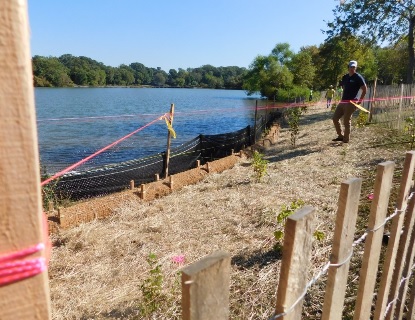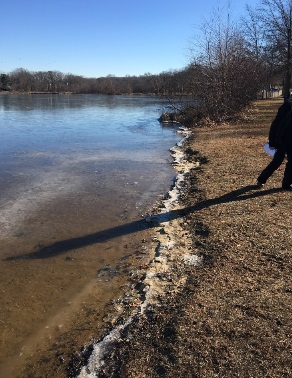
Shoreline restoration at the lake. String is tied
across the site to deter geese. Photo credit Michele Bakacs.
By Michele Bakacs, Rutgers Cooperative Extension, County Agent II/Associate Professor
Reprinted from Green Knight newsletter, Rutgers NJAES Cooperative Extension, February 2017
Manalapan Lake in Middlesex County’s Thompson Park received an ecological makeover this past fall when 600 feet of bare shoreline were planted with native plants. This shoreline buffer was established to prevent soil from eroding into the lake and improve habitat. Manalapan Lake is part of the Manalapan River Watershed which flows from Monmouth County north into Middlesex County eventually connecting with the South River and then emptying into the Raritan River. The project was conducted by the Freehold Soil Conservation District in partnership with Princeton Hydro and Middlesex County (including Rutgers Cooperative Extension, and Parks and Recreation). Funding was provided by the NJ Department of Environmental Protection 319(h) program.

Bare soil at Manalapan Lake.
Photo credit Michele Bakacs.
Shoreline erosion often occurs when the banks of a lake or pond are bare and the soil is exposed. Over time soil is eroded from the shoreline and deposited in the lake. Soil that has been deposited in a lake, river or other waterbody is then referred to as sediments. Shoreline erosion is a problem at Manalapan Lake because the area is mowed, is heavily used by people visiting the lake, and because Canada Geese congregate by the lake. Canada geese prefer open lawns next to waterbodies and they will often eat shoreline vegetation at the lake.
Other causes of shoreline erosion can be waves and ice hitting the banks or rainwater runoff from the land. Water quality is affected by erosion because sediments can carry with it nutrients leading to algal blooms. Heavy metals and other pollutants attached to sediment decreases water quality. Excess sediment increases the water’s turbidity and can also fill up the lake leading to expensive sediment removal.
The shoreline buffer established at Manalapan Lake incorporates native plants and biodegradable erosion control materials to stabilize the soil and stop erosion. A variety of trees, shrubs, and herbaceous perennials were utilized, many of which are adapted to the wet conditions along the shore of a lake. Over time, the plant roots will form a network that will stabilize the soil. Eventually, the erosion control materials will decompose allowing the plants to do most of the work. A healthy vegetated buffer protects the shoreline, soaks up pollutants, and provides beneficial habitat for many different species. In addition, Canada geese avoid areas where they don’t have a direct line of sight to the shore, so a shoreline buffer may also help reduce goose populations at the lake.
The shoreline buffer project is part of an ongoing restoration effort within the Manalapan Brook watershed that also includes naturalizing detention ponds to soak up stormwater runoff, and building floating wetland islands at the lake. These projects are in the Township of Monroe and Manalapan.
Two videos are available on YouTube that tell the story of this ongoing restoration effort:
Restoring the Manalapan Brook Watershed – An Introduction; and Floating Wetland Islands; Installation and Maintenance A third video in this series is under development document the shoreline buffer. For more information about this effort please contact Michele Bakacs, County Environmental Agent with Rutgers Cooperative Extension of Middlesex County at (732) 398-5274 or mbakacs@rutgers.edu.

